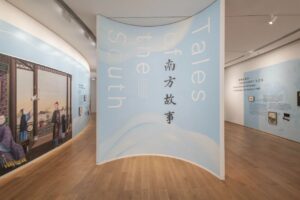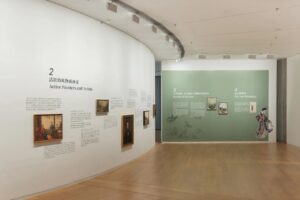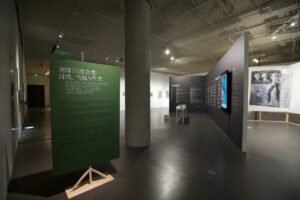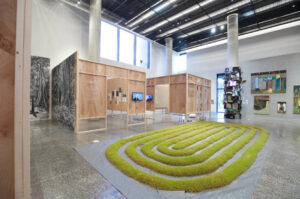Three reasons direct my medium focus in photography. One is related to my past working experiences in a photography art centre. Two is the inspiration I received from the group meeting, in which Haoxing mentioned the association between moving images with the diaspora. The last will be the accessibility of the medium itself, as well as the practicality for an emerging student-curator to operate the first conceptual curatorial practice. As Peter Weibel states “It is evident that the most influential paradigm in twentieth century art was the covert hegemony of photography (Weibel, 2013, p.17).” The universal impact brought by the emergence of photography on contemporary art is hard to overlook but through curatorial inspection.
In the first class, JL reminds us of the rationale in choosing the topic – the first thought and instinct. An artist I became acquainted with in the art centre came across my mind. What sharpens the image is my reflection on two exhibitions featuring themes on “the South”. Both the exhibitions, Nomads in the South: Rivers, Tunnels, Dampness and Constellations (2023-2024) and Tales of the South (2023-2024), feature the discourse of the geological south in China. Nevertheless, the two curators adopt different curatorial methodologies to develop the theme. The first project applies an overlapping curatorial approach between art and anthropology, in which the curator Cui Cancan took on a cross-regional fieldwork (Pingshan Art Museum, 2023), spanning nine southern provinces, and researched through interviews with artists to build on discourses (ARTDBL, 2024). While the latter exhibition surveyed and documented the morphology of the southern art landscape in chronological order.


Figure 1-2. Installation view of the exhibition Tales of the South (2023-2024). Images from the WeChat official account of HEM museum available at https://mp.weixin.qq.com/s/rjZPp4P4LgQ2SdGKS7kqVA


Figure 3-4. Installation view of the exhibition Nomads in the South: Rivers, Tunnels, Dampness and Constellations (2023-2024). Images from the WeChat official account of Pingshan Art Museum available at https://mp.weixin.qq.com/s/ri6E1e_nabyahirimV7ZZA
Emerging in the context of the celebration towards the global south, it is however suspected that the above curatorial practices mingle such conception with its geographical locality to be the fancy commercial gimmicks. When reflecting on my own project, being born in the southern part of China and the rising contemporary themes regarding the Global South somehow render me in a subtle state of duality. Above all, it leaves the question for me to examine such doubleness and to transcribe through curatorial discourse with my chose artist.
(words: 348)
Reference:
ARTDBL (2024) 崔灿灿:向南方学习. Available at: https://mp.weixin.qq.com/s/bzBEs8__AXnvR7fsCy3qMA (Accessed: 25 Jan 2024).
Nomads in the South: Rivers, Tunnels, Dampness and Constellations(2023-2024) [Exhibition]. Pingshan Art Museum, Shenzhen, Guangdong, China. December 23, 2023 – April 1, 2024.
Pingshan Art Museum (2023) PAM年度大展|跨越南方九省,101位艺术家,游牧在南方:河流、隧道、湿热、星群.Available at: https://mp.weixin.qq.com/s/10-ehTPT8Zh0VW0z_hkwow (Accessed: 25 Jan 2024).
Tales of the South(2023-2024) [Exhibition]. HEM, Foshan, Guangdong, China. December 12, 2023 – April 7, 2024.
Weibel, P. (2013) ‘The Global Contemporary and the Rise of New Art Worlds.Globalization and Contemporary Art’, in Belting, Hans. et al. The global contemporary and the rise of new art worlds / edited by Hans Belting, Andrea Buddensieg, and Peter Weibel. Karlsruhe, Germany: ZKM/Center for Art and Media. pp. 17


1 February 2024 at 17:10
Ningyue, you have included interesting content and viewpoints in your blogs.
Your second blog post begins to include a greater range of content, which is useful when considering what the blog is intended to demonstrate within the Curating course.
Your engagement with exhibitions is strong at present, but remember that the 200 word post is intended to be a very concentrated and carefully edited summary of all the research you are doing each week. At present, your blog posts do not reflect the amount of independent research that is expected on this course. Please be sure to make a checklist for yourself based on the Learning Outcomes of this course and JL’s advice on what your blogs should contain. As some examples of what this checklist should contain, make sure that each week you are documenting engagement with a range of complex scholarly sources on curatorial theory and your own personal theme (this includes both the assigned reading and the sources that you find for yourself), the reflection on your collective research as a curatorial collective, reflections on class activities. Your blog post should also contain your own broader reflections on the material as a whole, and some sense of your position within this–informed by all the research that you are discussing.
This will take time and effort to get right. Please do not mistake the short format of the blog post (200 words) as an indication that we are expecting only a small amount of content. Your blog should be a report of the much wider research that you are engaged in, and give a useful insight into a much larger body of personal research.